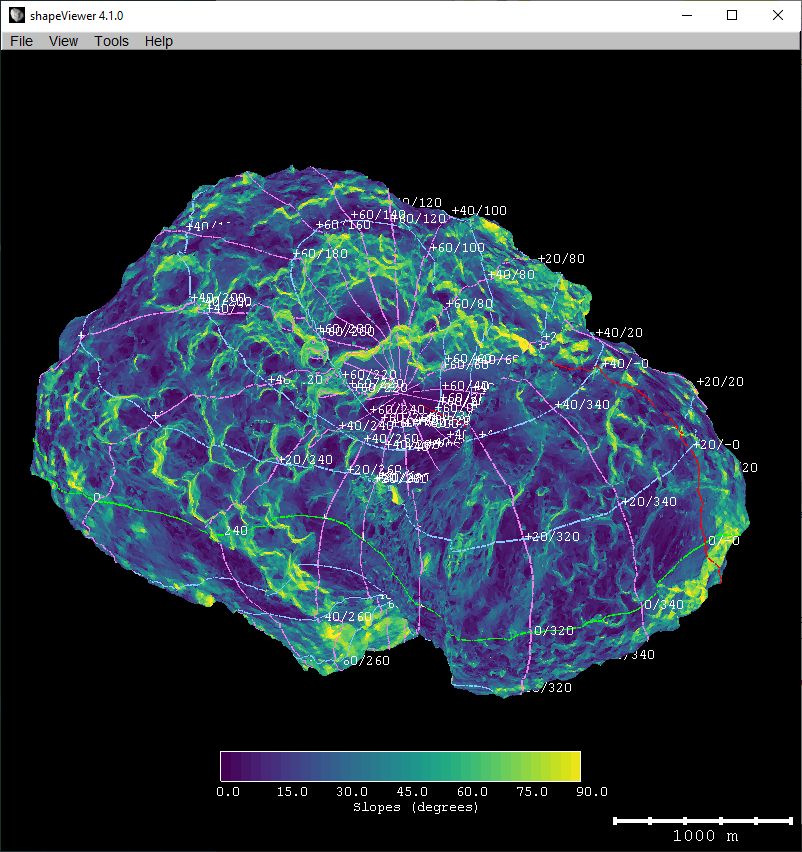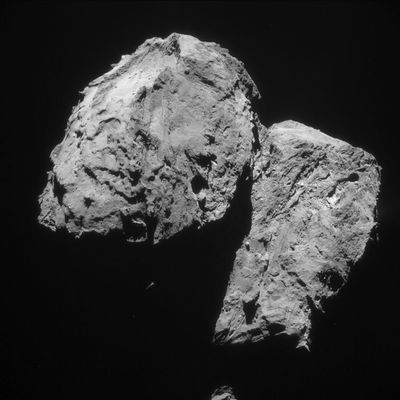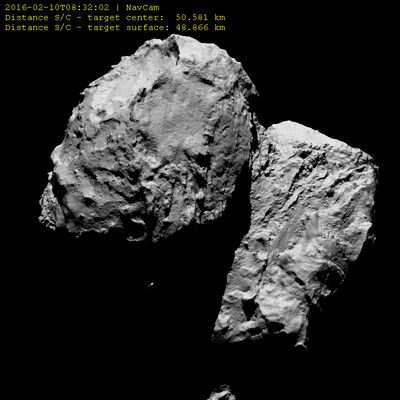screens at least 600 px wide
About
shapeViewer is a scientific software designed to display a 3D model of a celestial object in the context of a space mission, simulate observations and operations scenarii, and project data on the shape. It is freely available and distributed under a Simplified BSD License.
shapeViewer provides several tools specifically developed for mapping and geomorphological investigation. It is particularly suited for the study of small bodies (asteroids, comets, …) as it can handle display and mapping of highly convex objects.
shapeViewer has been used for operations planning and scientific analysis by the Rosetta (ESA) and Dawn (NASA) missions since 2010. It is currently one of the planning tools for the Asteroid Framing Cameras on board Hera (ESA) and will be adapted to Comet Interceptor (ESA) in the near future.
As of , the software has been referenced in 22 peer-reviewed articles and many conference contributions.
Features
- interactive visualization of asteroid and comets shape models, with accurate lighting and shadows,
- real time rendering of operational scenarios, spacecraft orbit and attitude pre-configured for each mission,
- retrieval of observation geometry and solar angles (incidence, emission, phase, elevation),
- calculation and display of the gravity field and effective slopes on the surface,
- projection of images and other datasets on the shape,
- view and export cylindrical, orthographic maps,
- high performance, even without a dedicated GPU,
- fully offline, all data is processed on the user's computer

Screenshots and movies

NavCam image
(2016-02-10T08:32:02)

shapeViewer simulation
of the same view

Projected NAC color data
from Oklay et al, A&A (2016)

Southern hemisphere of
asteroid Itokawa

Image mosaic projected on a slopes map of asteroid Vesta.

Same view as a map, with one of
the mutiple projections available
Download and install
shapeViewer is supported on Windows 10 and Debian 11, 64 bits systems.shapeViewer is provided as a single zip file. Extract it in the folder of your choice, and run the executable file for your system. The Windows executable can run on many Linux distributions and MacOS through the WINE interface. A graphic card supporting at least OpenGL 2.0 is necessary.
| (2024-01-10) |
The software is bundled with all necessary data to simulate the activities of ESA's Rosetta at comet 67P. More missions are available below.
To add a package, download the relevant zip file and extract it to the "missions" subfolder of your shapeViewer installation. New packages will be automatically recognized when you restart the software.
Note that the information content in packages is based on publically available data and user requests. Look at the detailed files of each mission to find the full credits for shape and orbital models.
| Mission | Target | Package |
| DART | Didymos | download (162 Mb) |
| Hayabusa | Itokawa | download (83 Mb) |
| Hayabusa2 | Ryugu | download (521 Mb) |
| Hera_ECP_PDP | Didymos | download (100 Mb) |
| Rosetta | 67P | download (162 Mb) |
| Rosetta | Lutetia | download (33 Mb) |
User manual
The latest version of the User Manual is available online.A PDF version with the same content is distributed with the software.
Terms of Use
If you use this software, I kindly ask you to include the following aknowledgement in your publications:
Reference: Vincent et al, shapeViewer, a sofware for the scientific mapping and morphological analysis of small bodies, LPSC (2018).
Publications
Selected list of peer-reviewed articles that made use of the software.- Vincent et al, Macroscale Roughness Reveals the Complex History of Asteroids Didymos and Dimorphos, PSJ (2024)
- Korda et al, (433) Eros and (25143) Itokawa surface properties from reflectance spectra, A&A (2023)
- Li et al, Numerical approach to synthesizing realistic asteroid surfaces from morphological parameters, A&A (2022)
- Jindal et al, Topographically Influenced Evolution of Large-scale Changes in Comet 67P/Churyumov-Gerasimenko’s Imhotep Region, PSJ (2022)
- O'Rourke et al, The Philae lander reveals low-strength primitive ice inside cometary boulders, Nature, (2020)
- Birch et al, Migrating Scarps as a Significant Driver for Cometary Surface Evolution, GRL, (2019)
- Vincent et al, Bouncing boulders on comet 67P, EPSC, (2019)
- Vincent et al, shapeViewer, a sofware for the scientific mapping and morphological analysis of small bodies, LPSC, (2018)
- Birch et al, Geomorphology of comet 67P/Churyumov-Gerasimenko, MNRAS (2017)
- Gicquel et al, Modeling of the outburst on 2015 July 29 observed with OSIRIS cameras in the Southern hemisphere of comet 67P/Churyumov-Gerasimenko, MNRAS (2017)
- Masoumzadeh et al, Opposition effect on comet 67P/Churyumov-Gerasimenko using Rosetta-OSIRIS images, A&A (2017)
- Oklay et al, Long-term survival of surface water ice on comet 67P, MNRAS (2017)
- Pajola et al, The pristine interior of comet 67P revealed by the combined Aswan outburst and cliff collapse, Nature Astronomy (2017)
- Vincent et al, Constraints on cometary surface evolution derived from a statistical analysis of 67P's topography, MNRAS (2017)
- Barucci et al, Detection of exposed H2O ice on the nucleus of comet 67P as observed by Rosetta OSIRIS and VIRTIS instruments, A&A (2016)
- Oklay et al, Variegation of comet 67P/Churyumov-Gerasimenko in regions showing activity, A&A (2016)
- Oklay et al, Comparative study of water ice exposures on cometary nuclei using multi spectral imaging data, MNRAS (2016)
- Vincent et al, Are fractured cliffs the source of cometary dust jets? Insights from OSIRIS/Rosetta at 67P, A&A (2016)
- Vincent et al, Summer fireworks on comet 67P. MNRAS (2016)
- Masoumzadeh et al, Photometric analysis of Asteroid (21) Lutetia from Rosetta-OSIRIS images, Icarus (2015)
- Vincent et al, Large heterogeneities in comet 67P as revealed by active pits from sinkhole collapse, Nature (2015)
- Vincent et al, Crater depth-to-diameter distribution and surface properties of (4) Vesta, PSS (2014)
- Vincent et al, Physical properties of craters on asteroid (21) Lutetia, PSS (2012)
